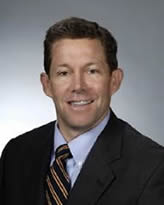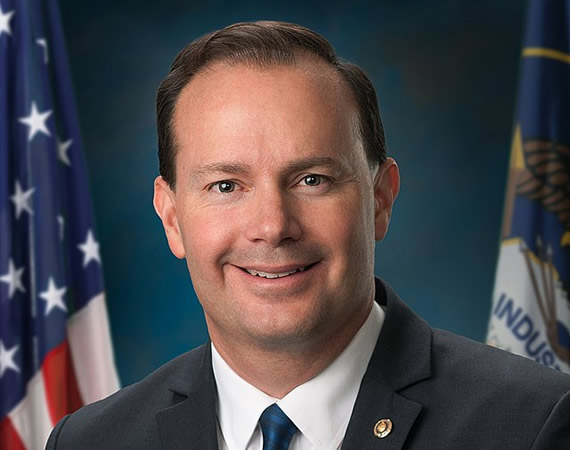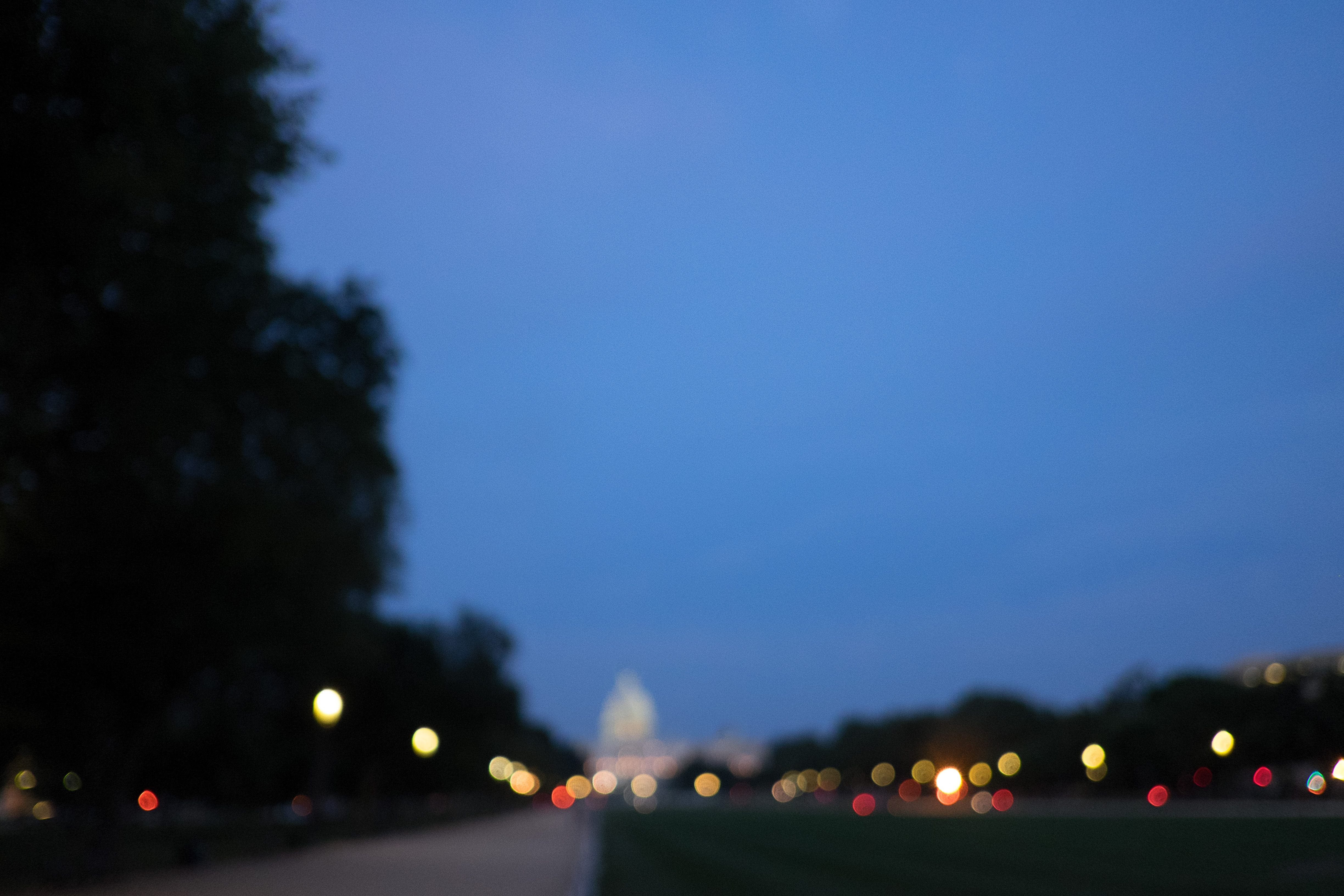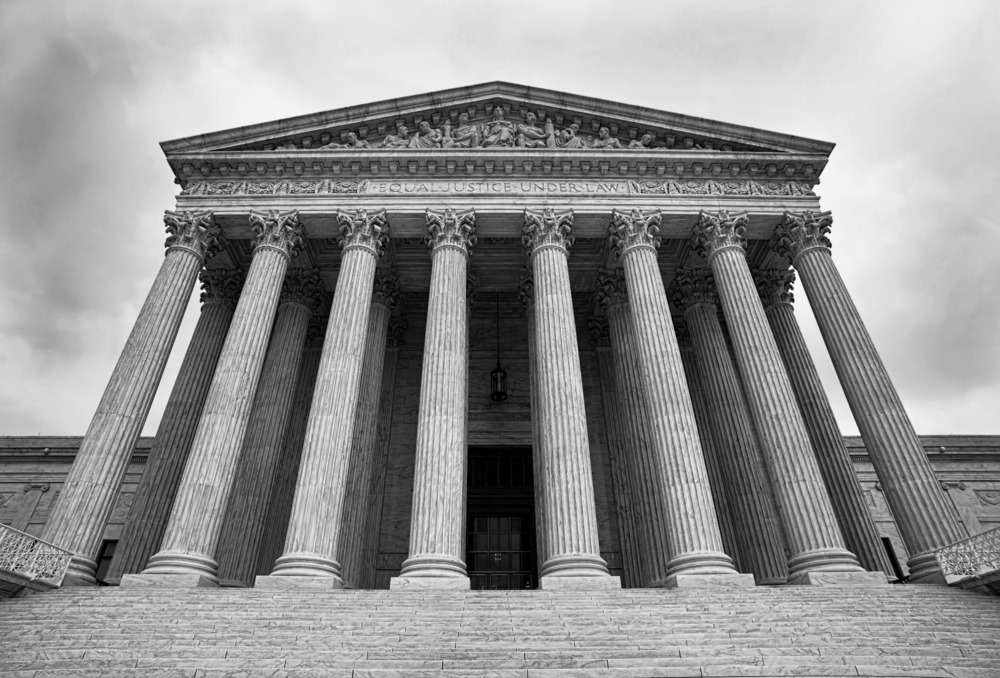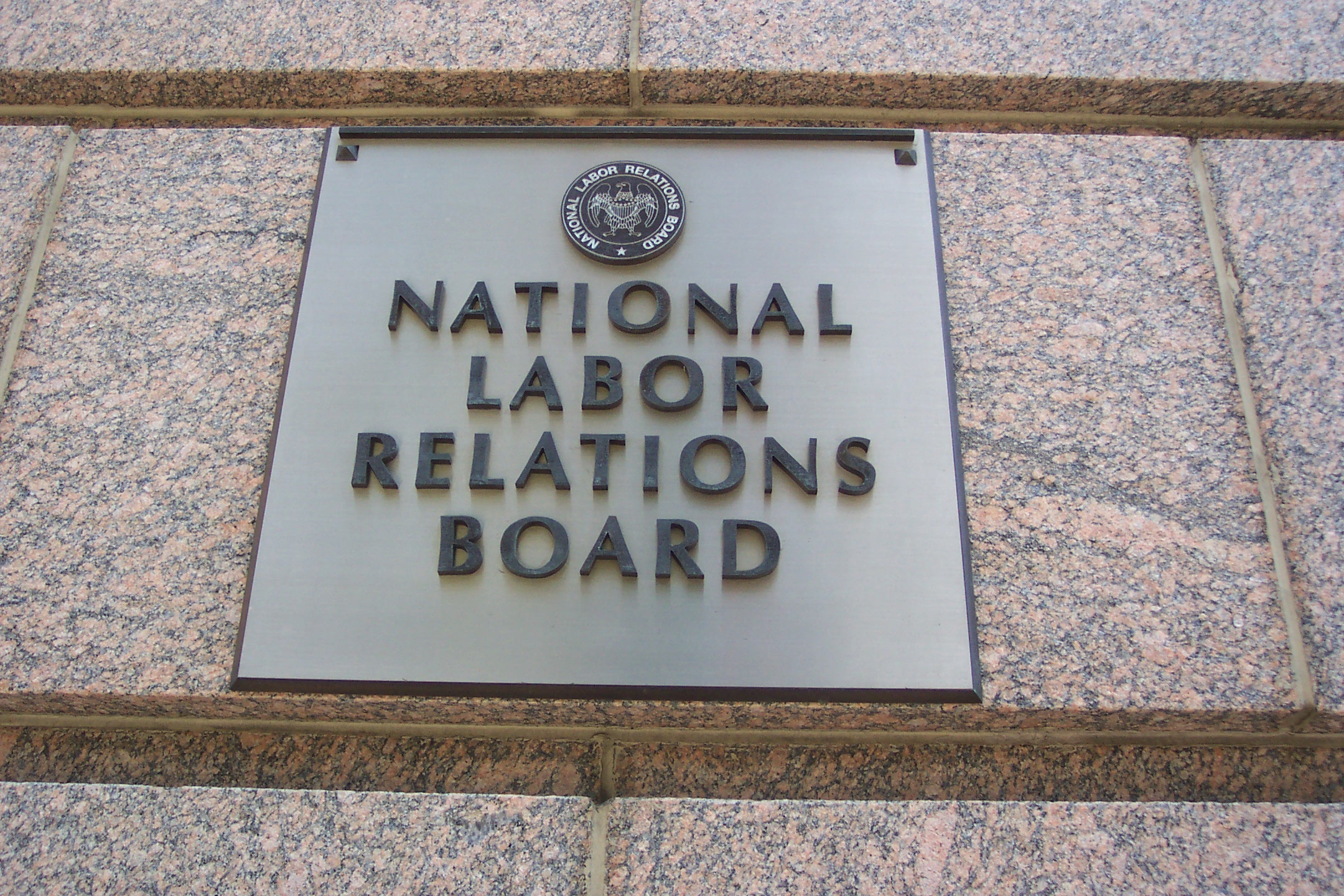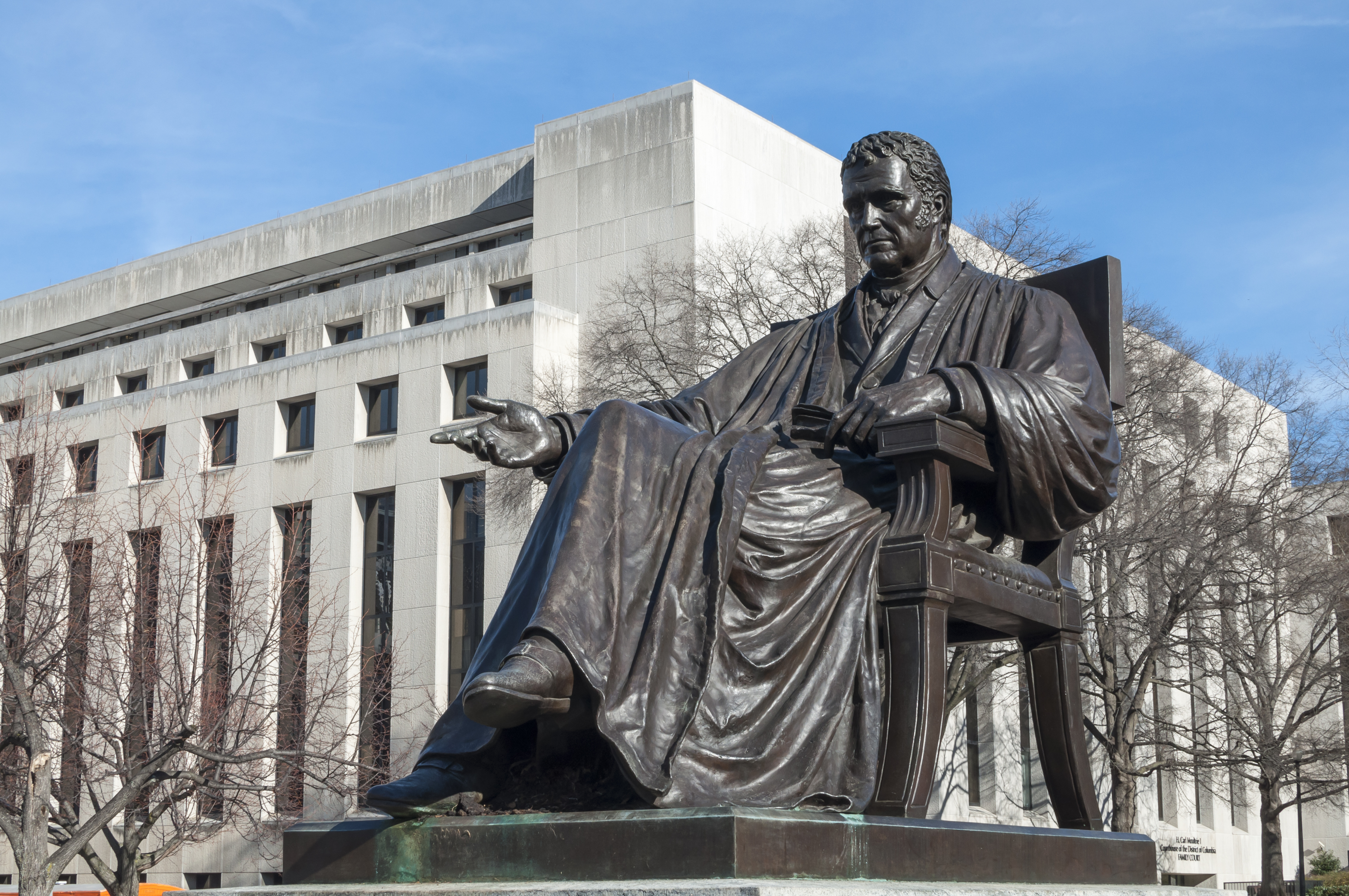When can the government require you to speak, or to host speech on your property, or to pay for speech you dislike? Three of the Court’s 2018 cases – the Masterpiece Cakeshop wedding cake/same-sex wedding case, the Janus union dues case, and the National Institute of Family and Life Advocates pregnancy crisis center case -- all involved this question. So do many other matters that are in the news: For instance, the controversy over whether people can be required to use particular pronouns to refer to others is in large measure a controversy about compelled speech. But the law in this area is surprisingly complicated, ambiguous, and unsettled. This panel will consider what the law is, and what the law ought to be.
Erik Jaffe: Hello? All right, we're going to get started. Hello? Hi. I'm Erik Jaffe. I'm the Chairman of the Free Speech & Election Law Practice Group, the sponsor of this panel. I just wanted to thank you all for coming and to invite any of you who are interested -- hopefully, everyone in this room is interested in free speech and election law issues -- to participate in the practice group, to get in contact with me or with Dean -- I said I'd mention Dean at least two more times, so Dean -- and join the practice group, maybe if you want to be in leadership or do some writing or anything like that. And without further ado, I would just like to introduce Judge Sandra Ikuta from the Ninth Circuit who will then take over, and moderate, and introduce the other panelists. Thank you.
Hon. Sandra Ikuta: Thank you very much. This -- can you hear me? Okay. I'm delighted to be back here at The Federalist Society National Lawyers Convention. And congratulations on finding this room. It was an intelligence test.
[Laughter]
I'm here today to talk about the First Amendment and compelled speech with three preeminent First Amendment scholars. Because an extended biography for each panelist is available in your materials, I think, actually, in your app, I'll just make a very brief introduction.
First, Professor Eugene Volokh, who I think probably doesn't need an introduction, is a Professor of Law at the University of California at Los Angeles. He's an extremely influential writer on First Amendment topics, as well as garnering fame for the well-named Volokh Conspiracy blog.
Professor Mark Rienzi, at the end, is a Professor of Law at the Columbus School of Law at the Catholic University of America. He's also the President of the Becket Fund for Religious Liberty and has broad experience litigating First Amendment religious exercise and free speech cases.
Professor Amanda Shanor is an Assistant Professor of Legal Studies and Business Ethics at the University of Pennsylvania Wharton School. Professor Shanor recently authored "The New Lochner," a provocative and very well-received article about the impact of the First Amendment on the administrative state. As an attorney in the ACLU's national legal department, Professor Shanor represented the gay couple in Masterpiece Cakeshop.
Please join me in welcoming our panelists. Before turning this over to the panelists, I'd like to have a few words about our topic today, government compelled speech. In 1943, the Supreme Court said, "If there's any fixed star in our constitutional constellation, it's that no official, high or petty, can prescribe what shall be orthodox in politics, nationalism, religion, or other matters of opinion, or force citizens to confess by word or act their faith therein. If there are any circumstances which permit an exception, they do not now occur to us."
So these stirring words are from the Court's landmark decision in West Virginia State Board of Education v. Barnette. In that case, the Court held that the First Amendment protects students from being compelled to pledge allegiance to the flag of the United States. And yet, every fall, I tell idealistic new graduate students from law school that they must raise their right hand and repeat after me: "I will support and defend the Constitution of the United States against all enemies, foreign and domestic, and that I will bear true faith and allegiance to the same." Now, at least one of my law clerks was shocked that she had to make that pledge. I don't know if this is a condition of the job as my law clerk, but AO Form 78a says, "Appointment is not complete until the oath of office is administered."
I mention this because it's sometimes difficult to see how the Court's compelled speech jurisprudence applies in the real world. For instance, the Supreme Court has held that the government cannot require recipients of federal funds to adopt a policy explicitly opposing prostitution and sex trafficking. According to the Court, it's a basic First Amendment principle that freedom of speech prohibits the government from telling people what they must say. And yet, the University of California, like many other public and private universities, requires all applicants for a faculty position, as a condition of appointment, to submit an EDI statement that describes the candidate's past, present, and future planned contributions to equity, diversity, and inclusion.
So the Supreme Court has also suggested there are limits on what messages the government can compel private individuals to post on their property. We just had that case last term. And yet, the federal government in most states compelled private employers to post multiple notices for the benefit of employees, including the employee's right to unionize and the right to be a whistleblower – information some employers might prefer not to disclose. And don't get me started on the regulations that require calorie information about my McDonald's Chicken McNuggets.
[Laughter]
So despite some great libertarian statements from the Supreme Court, it's clear that the government is constantly telling us what to say. The question is how far can the government go? The question was clearly on the Supreme Court's mind this term when it decided three important cases addressing these issues. That was Masterpiece Cakeshop, National Institute of Family and Life Advocates v. Becerra, and Janus v. American Federation of State, County, and Municipal Employees. The trail lines from these cases show at least some skepticism about the government's power to compel unwilling speakers to convey government-approved speech. So I'm as curious as you are about what these cases portend for the future.
And without further ado, I will let the panelists get started, starting with Professor Volokh.
Prof. Eugene Volokh: Thank you. And thank you very much for that excellent introduction, which I think highlights that this is an area that's pretty complicated. Often, you see the Court saying -- Riley v. National Federation for the Blind is a classic example, but Barnette itself also suggested the same -- that the rules for speech compulsions are as demanding as the rules for speech restrictions. And that's often said, and sometimes followed, and sometimes not. And then the question is, how do we try to rationalize this whole thing, how do we try to restate it in order for it to make sense? So what I'm going to try to do is I'm going to try to summarize what I think is the law of compelled speech, flag some unresolved questions that are really important, and also flag some things that we may think are resolved, but, I think, are not.
One thing I should mention, especially in light of the excellent examples given in the introduction, is I'm going to set aside for now the other tremendously important area, or I should say, the tremendously important portion of this that has to do with the government acting in special capacities like employer. Obviously, even sitting aside various oaths and such, if you go to work for the government at UCLA Law School, you better teach classes. And you say, "Well, I don't want to be compelled to teach classes." Well, not going to work, right?
Likewise, Barnette itself, I think one weakness in the opinion is it didn't do much to explain how the Pledge of Allegiance was different from all the other kinds of speech compulsions that are routine in schools. If you are called on, you have to answer, and if not, you might be marked down. You have to write answers on the exam. Often, you have to write the answers the teacher expects. I think there are possible distinctions, but I think they are complicated. I'm going to bracket this for now. All of the things, or almost all of the things I'll be talking about are government acting as sovereign, so it doesn't get any extra oomph for its control over the property, and yet, even so, it turns out to be very complicated.
So the first thing I want to say is there actually are two compelled speech doctrines. And that's not just me. You see that both in the cases, but also, you see it pretty expressly discussed in Rumsfeld v. FAIR, just many people miss that. One doctrine has to do with compulsions that actually act as speech restrictions. As we'll get to in a moment, some speech compulsions not just are treated the same as speech restrictions, they are, in fact, speech restrictions. Those, it's pretty easy to say they should be treated as speech restrictions, although then, of course, the question is how exactly? But then there's what I call stand-alone or pure speech compulsions, like in Barnette or in Wooley, the license plate case where it's not restricting anybody's speech by requiring them to pledge allegiance, it is purely compelling it. And then one question is how you deal with that. Again, you might say, "Well, it's the same as speech restrictions." Turns out, just looking at the cases, it's not. And then the question is what is it?
So let me just quickly run through the compulsions that are restrictions. One classic although rarely used or rarely seen example is you might think of a content-triggered compulsion, not just you must say something, but you must say something if you've said or published something else. Classic example, Miami Herald v. Tornillo, the right of reply law statute. The Supreme Court struck down a Florida statute that required newspapers to publish replies from candidates for office that were being -- or office holders -- that were being criticized in the newspaper's pages.
And one of the rationales the Court gave is it's essentially a content-based tax. If you were to say any time you criticize or allow the criticism of a candidate, you have to pay even $10, clearly unconstitutional content-based tax. Well, if you were to say you have to hand over, for free, portions of your precious column inches of the newspaper for the reply, that, too, is a content-based tax. I mention this in part because Miami Herald is a prominent case, and in part because if you want an example that is most uncontroversially a speech compulsion that is a speech restriction, there is little doubt that that's so, and the Court has treated it that way.
Now, here's another possibility, and this what I call interference with a coherent speech product. You might say, "Well, what is a coherent speech product?" That turns out to be one of the problems. But it is clear that the Court recognizes sometimes speech compulsions being restrictions when they, by requiring you to add something to some speech, they basically make it impossible for you to convey the speech you want, which is this, without the addition. And the famous line from the Court is, "All speech inherently involves choices of what to say and what to leave unsaid."
So here's a -- one example is Miami Herald, which had an alternate holding. It said even apart from the content-based tax, if you require that a newspaper include some speech, you're interfering with the newspaper's ability to publish a newspaper that doesn't include that. That's most clear if you think about a magazine. Imagine the National Review were required to publish left-wing publications -- or, excuse me, articles -- and The Nation was required to publish right-wing articles. It would be a very different magazine. You wouldn't have magazines of opinion the same way that you have now.
Classic example of that is Hurley v. Gay, Lesbian, & Bisexual Group of Boston case which involved a parade. And there, there was a requirement that it was interpreted by state courts as saying that, essentially, a parade could not exclude a pro-gay rights group. And the Court said, "Look, the parade is all about the floats that are chosen to be in it, and this is both the floats that are included and the floats that are excluded." And Wacko Hurley, I think was his name, the parade organizer, the guy who was apparently in charge of the parade, is entitled to choose which floats are included and which are not.
Another example is McIntyre where there's a ban on anonymous leaflets. There's a whole separate doctrine dealing with anonymity, but even setting that aside, the Court said, "Look, by requiring the inclusion of a name on a leaflet, you're interfering with the ability of the author to choose what to include, such as to choose not to include her name." And Riley was an example of where the government required people to -- fundraisers to include in their fundraising pitches information about how much of the money actually ends up in charitable hands. That, too, the Court said was an interference with free speech, and I think it's because the pitch was seen as this coherent speech product.
And most recently in NIFLA, the Court's rationale was, "Look, if you require pregnancy crisis centers to put up signs talking about the availability of abortion, that affects their ability to present to their clients the speech that they want by requiring them to include other speech. So you might say, "Okay, fine. Why not just say you can't be compelled to say anything, or you can't be compelled to display anything. Remember, NIFLA, for example, involved display and not speech; likewise in some measure, Hurley.
Well, let's look at three other cases. PruneYard, the Court unanimously held that a shopping center could be required to allow leafleters on its property. And part of the rationale, if you look at the case and later cases justifying PruneYard, was that, "Look, it doesn't interfere with the shopping center's owner's own free speech." Now, you might imagine that every shopping center is creating a coherent speech product, kind of the overall look and feel of the center. And of course, there may be signs, there may be Christmas decorations, and various other things. But the Court's view is that people just don't view that as a coherent speech product.
It was even more clear in Turner Broadcasting where a cable system was required to include various channels it didn't want to include. The Court said no speech compulsion. There, it was 5-4, in part because nobody perceives a cable system, like Spectrum or Time Warner Cable as being a coherent speech product. Now maybe—the Court didn't deal with it—but maybe a cable channel might be seen as a coherent speech product, but a cable system was not.
And most recently in Rumsfeld v. FAIR, the Court upheld a requirement that universities allow military recruiters. Many universities were excluding them because the military, at the time, was discriminating based on sexual orientation. I guess that makes -- what is the current status? But any case, certainly, at the time, it was under "Don't ask, don't tell." And the Court upheld that. Now, note the statute was written as a condition on funding, but the Court said we don't even have to deal with the unconstitutional conditions doctrine because even if this were just a mandate, a flat requirement, it would be constitutional. So we're going to talk about Rumsfeld the same way the Court talked about Rumsfeld—or FAIR is usually the way it's referred to—as a government is sovereign case because the Court said it's okay to require universities to allow these recruiters on, at least if they have other recruiting. Well, in the process of doing that, it said it doesn't interfere with the university's own speech. Again, it viewed this as not a coherent speech product.
As you might gather, there ends up being some controversy about what is and what is not a coherent speech product. What if a book store were required to stock certain books, or not discriminate based on race, let's say, in the authorship of the books, or sex, or some such? I'm inclined to say that would be a coherent speech product, but as you might gather, one would need to navigate, or need to figure out whether you're closer to these three cases or to the other cases.
Now, this brings up the question of pure speech compulsion. Now, you might say, "Well, PruneYard and the other cases, well, they're not -- don't involve pure speech compulsion because nobody's being required to speak as such," although we'll see that's actually a bit more complicated. But the Court has said that not only compelling people to say things, but compelling people to display things, as in Wooley v. Maynard, display a slogan on a car license plate, is a speech compulsion. And compelling the funding of speech in Janus, the Court said is a speech compulsion, even when the government is acting as employer. Okay, that sounds good, but compelling the hosting of speech on your property—PruneYard, Turner, FAIR—that doesn't seem to be a speech compulsion.
Now, I can tell you I think this is the line, in a sense, that the cases draw, but one interesting question is why? Why is compelling you to pay your money to a union—not an unconstitutional speech compulsion—but compelling you to hand over your property to military recruiters or to other leafleters, that is -- excuse me, the compelling to pay your money is a speech compulsion; compelling you to turn over your property is not a speech compulsion. If anything, you might think it's the opposite that in a sense, you have more connection, more affiliation with your property than just with the money in your paycheck. In any event, the Court has never really fully explained this, and I think that's an interesting and complicated conceptual question.
Now, there is actually a possible way of reconciling all these cases, which I'll get to in a moment, but there's one other question. In PruneYard, the Court stressed that one reason maybe it was okay to compel shopping centers to allow leafleters on their property is because the shopping center had to allow all speakers equally. So it was, in a sense, a content-neutral speech compulsion. It isn't just not triggered by the speech of the shopping center. It's not affected by the speech of the proposed visitor. But then along comes FAIR. Universities only had to allow military recruiters. It wasn't that the university had to allow all recruiters if it allowed some, it only had to allow military recruiters. That's pretty clearly a content-based compulsion, I would think.
What's the current status? We don't know. And that turns out to be important because some states do have content-based compulsion, so some states say you don't have to allow, as a shopping center owner, everybody on your property, but you do have to allow people who are gathering signatures for initiatives in referenda; viewpoint neutral, but clearly content-based. Is that constitutional? Turns out, we don't know. There's actually a dispute between the Cal Supreme Court and the D.C. Circuit as to whether states can say property owners have to allow unions but not other speakers access to their property. That, too, not clear because the Court seems to say one thing in PruneYard and another thing in FAIR.
Now, see, here's a possible rule, and I claim this rule actually connects or restates well the cases. The problem is it's not at all clear that it makes any sense. And it restates the cases both as to funding and as to property access. You might say compulsions of turning over either your money or your property are okay if they benefit all speakers neutrally -- there's actually a funding case on that called Board of Regence v. Southworth, which involved student dues funding that ended up going to a wide range of student groups -- or if it benefits just government speakers. That could explain FAIR v. Rumsfeld. It could also explain why the Court said it's impermissible to require people to pay money that ends up going to unions, but permissible for the government to require people to pay money that goes to the government in taxes for speech, among other things.
Among other things, in a union labor management negotiation, it's not just under the old pre-Janus regime, it wasn't just the union that was funded by compelled funds, it was management, too. Management is the government employer. It's obviously funded by compelled tax money. So that rule captures well what the results are in the cases, but again, it's hard for me to see why it is that compulsions that benefit the government speakers would somehow be better than compulsions that benefit union speakers, let's say, or that benefit other speakers. Very hard to know.
So here's another thing that's uncertain: compulsions to state facts. Riley says compelling statements of fact like, "80 percent of the money I raise is going to go me and my colleagues and not to the charity," just as bad as compelling statements of opinion. But in FAIR, one of the things that the law required universities to do is send around emails announcing where the recruiters are, not just allow them on the property, but actually to talk about them the same way they talk about other recruiters. The Court says, "Well, that's a far cry from the compelled speech in Barnette and Wooley." Why? Well, maybe because it's a compelled statement of fact and not of opinion, but what about Riley? Very hard to tell.
This turns out to be really important because there are lots of compulsions that state facts. Some of them might be facts about here are the legal rules that are available for employees, but sometimes they're just pure facts. Like, for example, what about compelled reporting of crimes one witnesses to the government? There's no such general law, but many states have such laws, and many states have laws requiring reporting particular kinds of crimes. Interesting of the Second Circuit in the highly unusual case struck down one of those laws on compelled speech grounds. Other courts have upheld them.
What about compelled reporting of financial information, such as tax information or information to taxing authorities, whether income tax, sales tax, or whatever else? What about compelled reporting of information to the census? Or how about the Maynards? They had to show up at the DMV, presumably, and convey all sorts of information. And again, you could say, "Well, but that's different from a 'live free or die.' That's facts." Okay, but then what do you do about the Riley line that facts are treated the same as opinions?
So let me finish up with a few things. So one thing is it looks like there is a doctrine that compulsions incidental to conduct requirements are permissible on this notion that when the government is regulating conduct, it can incidentally regulate speech; extremely troublesome notion, very ill defined. I do think there's a way of rationalizing it. I wrote an article all about it a couple of years ago in Cornell, but what it looks like in this context is when people engage in non-speech conduct, they may be required to provide information either describing the conduct and its consequences or alternatives. That's the rationale the Court gave in Planned Parenthood v. Casey as to why informed consent is to be required -- can be required for abortions, although it's an interesting question how reconcilable that is with NIFLA, although I think it could be, or if it's the sort normally provided by the people with regard to similar conduct.
So you might say for an ordinary anti-discrimination law case is if a restaurant has to provide service to people without regard to race, it includes the speech component of the service. Like you can't say, "Okay, we'll pay you the food, but we won't tell you what the menu is." We won't show you any menus because that's compelled speech. So that might explain the situation in FAIR, but again, note this is weirdly bumpy, almost gerrymandered doctrine. Does it make much sense? Maybe. I think this may make more sense than the one I just talked about before. But at least, you need something like that to reconcile the cases.
Let me close with two items. One is compelled commercial speech. What can you be required to post in your ads? It looks like the rule is government may compel commercial advertisers to include government-mandated purely factual and uncontroversial information about their goods and services. Well, what about controversial information? What about not purely factual? It looks, in the face of NIFLA, that they can't require that, but there is a good deal of controversy about how much -- about where those lines are drawn, among other things, what constitutes uncontroversial information?
The last question is one that is on many people's minds, was at the time of Masterpiece Cakeshop, and continues to be because, of course, the Court never resolved it there. What do you do about compulsions to create speech, like compulsions to take photographs, or compulsions to sing wedding songs, or compulsions to make calligraphy invitations? Even if the compulsion is articulated as a non-discrimination rule, it stills compels the creation of speech. Are they like compulsions to display speech as in Wooley, or are they not? And then, of course, one of the key questions in which I differ from many of my conservative friends in Masterpiece Cakeshop is what constitutes speech? If you've got a speech compulsion, what about the cake? Is that speech? What about photography? I think, and given the Judge's background in journalism and her husband's background in photography, she might, without admitting it, agree that photography is speech. What about florists? Say it with flowers? Is it?
[Laughter]
So those are some of the many questions that remain unresolved.
Hon. Sandra Ikuta: Well, as you can imagine, appellate judges love to hear that there's a discernable rule that makes no sense.
[Laughter]
And so we hope that Professor Rienzi will make some sense over compelled speech and religious objections.
Prof. Mark Rienzi: Great. Thank you, Judge. I'm going to try to give you a good rule. First, I'm honored to be here. Thank you all for coming. Thank you for having me here. It's great to be here with this panel. Let me give my normal disclaimer which is I have a whole lot of employers, I have a whole lot of clients, and I'm not here to give their views, I'm here to give mine.
Americans disagree on all sorts of big and important questions. We disagree about religion, sex, marriage, life, death, war, peace. That's okay. That's the natural consequence of free people who are allowed to think for themselves. If the government could dictate an orthodoxy on those questions, if the quote from Barnette were not right, if the government could tell us the answers, it would be easy because we wouldn't disagree. We'd have a little less friction because we'd all think the same thing. But we don't, and I suspect most of us don't want to live in that world.
The reason we don't live in that world is that the First Amendment protects the right of people to come up with their own answers to those deeply important questions, even though our answers on deeply important questions might cause our neighbors distress, might be bothersome, or hurtful. The First Amendment protects the rights of minorities to come up with their own views, and it protects us all from the government, whichever side, left or right, deciding that it knows the one and only right answer to some deep question about morality, or sex, or life, or death.
What I'd like to do today is talk about just two cases. Eugene did a great job giving the broad overview of all the complexity. My effort here is really just to focus on the two big cases at the Court last term that I think set up some pretty clear rules, NIFLA and Masterpiece, because I think they both run afoul of the same big and important principle, which is that the government can't pretend to decide the one and only right answer to big questions and then force everybody else to either embrace that answer or help mouth or say that answer to others. That's a big, dangerous thing for the government to do. The fact that they tried it in NIFLA and Masterpiece is a bad thing. The fact that those cases came out the way they came out is a very good thing.
If you look at both NIFLA and Masterpiece, there are two similarities that I want to point out before I walk through some details. One is that I think each one really is about a forced embrace of the government or the majority's proposed orthodoxy on a particular issue, whether it's the proposed orthodoxy on people really ought to be offered alternatives to abortions, or people really ought to be willing to sell or participate in some way in celebrating a same-sex wedding. In both cases, what I think those cases really are about is the message, and I think it's the message that got people regulated. It's the message that got people upset, and I think that where -- that's what the governments actions are all about, where the actions really are all about either stepping on a message the government doesn't like, or forcing people to clap their hands, or salute the flag, or otherwise support a message that they don't like. That's when the First Amendment has its most important work to do. And I think it did it well in NIFLA and Masterpiece.
Secondly, I think if you look at both cases, you'll also find that the harm at issue, while in some cases arguably real harm, is not the kind of harm that we would normally accept in any other First Amendment context as allowing the government to tell people what they can or should say. In other words, the harm, I think, at most, that can be dragged out of those cases is the harm that is essentially the natural consequence of living with people who have different beliefs than we do.
And so all of us as members of a free society have to deal with the fact that we may have beliefs, we may have parts of our identity, we might have religious beliefs that our neighbors may think are evil, awful, and wrong. And it may be very hurtful to hear somebody say that or hear somebody say that they don't want to celebrate or be part of something with us. But I'll submit that I think that's the natural consequence of living in a free country, living in a pluralistic place, is that unless someone's going to make us all think the same things, sometimes we'll have disagreements. Sometimes they'll be about really important things, and most of the time we shouldn't want the government to come in and crush our opponent. We really ought to just live and let live.
Let me start with NIFLA. The NIFLA case really grows out of something that had been going on since 2007 or 2008, which is an organized push by pro-choice groups nationwide to try to control or undermine the speech of their opponents, namely crisis pregnancy centers. The point of those restrictions, to my mind—and I think the evidence ends up showing it by the time we're done with NIFLA and some of the other cases that wrapped up around the same time—the point of those restrictions was always to control or undermine somebody's unpopular speech.
The claim was made that pro-life pregnancy centers are dangerous. They're misleading women. They're convincing women to not seek medical attention in ways that ends up harming them. Those claims were made over and over in all the places for the laws. But if you look at the ones -- and NIFLA wasn't one that actually got to discovery and trial because it was resolved at preliminary junction stage -- but if you look at the cases that actually got litigated where you had to come forward with evidence to prove the claims of harm, the truth is there was no harm there. And I'll get to that in a second.
If you need any convincing about the fact that the pregnancy center speech regulations were about controlling or undermining your opponent's speech, let me just tell you about the very first of these proposals. It was a state statute in Maryland, and here's what the state statute in Maryland required anybody to say before they wanted to have a conversation in which they are providing information about alternatives to abortion. So the law only applied to people who wanted to provide alternatives to abortion. If you're pro-choice, if you're an abortion clinic, you didn't have to engage in this speech. But you had to start your conversation with the following disclaimer: "I am not legally required to tell you the truth."
Now, on one hand, like here's what you can say for that. It's true. You're actually not usually legally required to tell the truth. But I think it's very clear that anything along those lines is obviously designed to undermine the speaker in the listener's mind. That's the reason you would have somebody start by saying, "Hey, I'm not obligated to give you the facts. I can just make stuff up." Try saying that in your next job interview or your next blind date.
[Laughter]
It's a great starter. It's true. I suspect they won't last long.
The Maryland law actually failed, but the pro-choice group succeeded in a handful of fairly liberal municipalities -- Baltimore, Montgomery County, Maryland, New York, Austin, San Francisco. And then a few years later, a few states passed these laws. And there's a variety of different types of the pregnancy center laws. Some of them require what California required for at least some of the speakers, which is a sign saying, "Call this number and the state can provide you with free access to abortion." Some of them required statements that, "We're not doctors, and the government thinks you ought to go see somebody who has doctors." Some of them required statements about, "We don't provide abortion." So a range of different things, but they all have one thing in common, which is they're all targeted solely at the pro-lifers.
Leading up to NIFLA, those cases were almost entirely losses for the pro-choice side, and then NIFLA, of course, was a loss for the pro-choice side. And I want to give two reasons why it was a loss, and then just tell you a couple things from some of the lower court cases. One reason NIFLA lost is -- so NIFLA, California were saying, "You've got to put it on your wall that California will provide people with free services, including abortion, and here's the phone number to call." The problem with that requirement is that it's really hard to get past the idea that California could do that itself.
This is the State of California. They've got one of the biggest GDPs in the world. They don't lack for a mouthpiece when they need one. The idea that California needs pregnancy centers to tell people that California offers free stuff is just a pretty weak argument. It's a pretty dumb idea. California can actually tell people whatever it darn well pleases. It can advertise it on every billboard and radio station in town, and they just don't need to make the pregnancy centers say, "Here's where you go for your abortion." So I think it was obviously gratuitous. And I think that's also true of the other kinds of regulations. If the state thinks there's something important to say about crisis pregnancy centers, they can say it. No one stops the government from saying it. But it's a little bit odd to say that the pregnancy centers need to say it by themselves.
At times, these governments have argued that it's commercial speech. And we don't really have time for that argument, so I'll just take 20 seconds on it, which is to say if pregnancy centers that provide help and advice for free, often in the basement of churches, if that's commercial speech, then everything is commercial speech. And that may be an appealing idea if you're California or one of these governments that's really looking hard to find a way to regulate somebody's speech, but it's a really terrible idea for the First Amendment. It's a really bad idea. People get all sorts of free information and advice from all sorts of places. The idea that the government gets some extra power to regulate it is a real dangerous idea.
The second reason these cases lost is that there's just no evidence of a real problem that needs regulating. And let me give you two objective ways that you can tell there's no evidence of a real problem that needs regulating. So the State of California argued that one of the problems, one of the things we worry about is people fakely pretending to be medical clinics when they're not really medical clinics. And so we need to make them put a sign up that says, "We're not medical." They only say you need to do this if you want to talk about pregnancy. If you want to talk about drugs, or AIDS, or any other important issue, they don't make you put up such a sign. It's only about pregnancy options that they want it.
And it's already against the law to falsely pretend to be a medical clinic when you're not. If California had any evidence of even one of these places pretending to do that, Javier Becerra, the Attorney General, would've been delighted to prosecute them. The fact that he didn't, the fact that they needed to go past a different law to get the pro-life groups, is actually the best evidence you have that, oh, they really weren't violating the existing laws.
It's a little bit like the abortion clinic buffer zone case, McCullen v. Coakely, that the Supreme Court heard a few years ago. There, the claim was, "Well, we need to have a buffer zone and keep even the peaceful, consensual speakers back because there's a lot of door blocking going on, and there's a lot of violence going on, and there's a lot of problems at the abortion clinics that we can't police." And the Supreme Court, all nine Justices, left, right, and center, said, "Well, no. You actually have laws against that stuff. And if somebody's blocking the door, you should go prosecute the person who blocks the door. And if somebody's harassing people, you should go prosecute the person who harasses people. And if someone engages in violence, you should go prosecute them. But you certainly can't use that as a club to attack peaceful, consensual speech," which is what was going on there, and why Massachusetts lost that case nine-nothing.
I said the NIFLA case didn't go to discovery, but a couple of the cases from Maryland did. And I just want to read you two very quick quotes. So the Baltimore case took seven years of litigation. I was involved in it. The Fourth Circuit Court of Appeals sent it back down to make sure Baltimore had a long period of time to get as much evidence as it could. By the end of that case, the Fourth Circuit panel, which included one of the judges who sent the case back down for more evidence, said that "the city could not identify a single example of a woman who entered the center under the misimpression that she could obtain an abortion there." And then this is from the district court opinion quoting the city's own heath commissioner, "The city does not know of any instance when a person has visited a pregnancy center in Baltimore who was harmed or delayed in seeking medical care."
And the Fourth Circuit said that after seven years of litigation and a 1,300-page record, just no evidence. There actually wasn't a problem there. In Centro Tepeyac, which was the Maryland case heard by Chief Judge Deborah Chasanow, a Clinton appointee. Chief Judge Chasanow eventually concluded that the county had no evidence that the centers were causing pregnant women to be misinformed in any way which affected their health. She pointed out that the county's Chief Health Officer testified that she had never received one complaint in the eight years she had been the county's Chief of Public Health. So the fact of the matter is these were fake claims from the beginning. The government had no good reason, and what was really going on was an effort to enlist the government to silence your opponent and to make your opponent violate his or her deeply held beliefs. Those cases lost mostly across the country before NIFLA, and then they lost at the Supreme Court.
Masterpiece. Masterpiece, of course, wasn't decided on speech grounds. It ended up being decided on religious liberty grounds. Some people will tell you Masterpiece was a really narrow decision. I don't think that's quite right. I actually think using the religious liberty ground actually makes it broader than it would have been on speech. I actually think the cake really was expressive. I think people actually believe that weddings are really, really important. That's why both sides fight like heck over them. People actually believe the wedding cake is really important. That's why people spend a fortune on it. That's why it's worth fighting about. People actually think the wedding cake is a really big, important symbol at the wedding. I think all that's actually obvious if you take it out of this context. I don't think it's really terribly debatable.
I think if somebody were refusing to make big celebration cake for the Trump inauguration, people would not have a difficult time figuring out that, "Oh, maybe they feel like they're expressing a celebration about something they don't want to celebrate." So I don't think the speech question was actually quite as hard as everybody made it out. I do think the Justices felt like, "Well, I don't know where to draw the line after cakes." I think that was clear in the oral argument that they were searching for that line, and I don't dispute that there could be some difficult line-drawing there. I just don't think the cakes were on the difficult side of the spectrum.
But again, the Court didn't decide it on speech grounds. They decided it on religious liberty grounds. And that makes Masterpiece a broader decision. If it was just a speech decision, in all follow-on cases, you would sit around and say, "Okay, but is it expressive like a cake, or is it not as expressive as a cake?" And I think in a lot of these cases, the religious liberty ground is, in some ways, the stronger ground. It's certainly the broader ground. In other words, you could imagine a situation where someone says, "Look, I can't participate in X," whether X is a same-sex wedding, or building the turrets on a tank, like the Thomas case, or something else. Someone says, "I can't participate in that. I can't help that." Well, sometimes, their help will be speechy, but sometimes it won't. And deciding Masterpiece on religious exercise grounds actually makes it more broadly applicable.
The other reason some people suggest that Masterpiece is narrow is they say, "Well, Masterpiece was actually based on the fact that there was this obvious discrimination going on from the government. The government actually said some mean things about the religious guy. They said that his religious claim was just a cover for discrimination. They compared it to racism and other atrocities, and therefore this is narrow and idiosyncratic." I don't think that argument is going to hold up too well over time, and I think that's an argument that you might make if you don't litigate many of these cases.
But I actually don't think the Colorado Civil Rights Commission was too far afield from what a lot of governments sound like when they impose these types of requirements. And just to give you one example, a case in Philadelphia right now which I'm working on, Fulton v. City of Philadelphia, where the City of Philadelphia is trying to shut down Catholic charities from doing foster care in the city. So this is a ministry that Catholic has been doing for far longer than the City of Philadelphia has been doing it. And what the city said is, "Look, you can't keep doing that unless you will do home studies. You'll do the evaluations, and you will approve same-sex couples to be foster parents."
And the Catholic Church, this probably is not much of a surprise, says, "Look, we actually can't do those home studies and say that would be a good place to raise kids. We also don't do it for unmarried, heterosexual couples." The Catholic Church just has some beliefs about sex and marriage, and they're not trying to forbid other people from fostering or adopting, they just say, "Look, if that were to come into my door, I would honestly say to somebody, 'Look, we really probably shouldn't be the ones to go into your house, and study your family life, and give people opinions on that. You probably would rather have somebody else do that.' " Philadelphia said no, said, "Unless you say you will do those certifications and give your stamp of approval, you have to get out of the foster care business entirely."
Here is what the government agents from the city said to Catholic Charities. They called them into the government office, and they said, "Look, you're going to do these certifications or we're going to shut you down." And they said that when Catholic said, "Look we're not trying to discriminate against anybody, we just want to stand aside. These are our religious beliefs." They said, "Well, it's not 100 years ago anymore, and you really ought to be following the teachings of Pope Francis rather than of your local archbishop." And by following the teaching of Pope Francis, the government administrator thought, clearly meant her understanding of what she thinks Pope Francis thinks. The mayor tweeted that he didn't care about the people in the archdiocese, that they were mean and unchristian. The city council said, "We need to have an investigation to root out discrimination under the guise of religious liberty." And then, sure enough, the commission went ahead and only looked at religious agencies but didn't look at secular agencies.
At the end of all that, they just shut them down. They said, "No more foster kids for you. No more foster kids for any parents who've been approved by you," so that Philadelphia right now has several hundred children who they need foster homes for. Catholic, at last check, has about 35 homes that they are pre-approved parents who would take those children. Philadelphia won't put them there because those parents worked with Catholic.
The most outrageous piece of that is that no gay couple has ever even asked the Catholic Church in Philadelphia to do that kind of review. And it's outrageous because it means that there actually was nobody really harmed. It's also heartening, and the reason it's heartening is that it shows that in the real world, people can actually live and let live, and disagree. In other words, I actually think it's a great thing that the conflict didn't -- it's not like the Catholic Church is luring people in, saying, "Come on in here. Okay, great. Now, I'm going to deny you, and you can't be a foster parent." They just don't want to be the ones to do the certification at all. And it shouldn't be all that surprising that gay couples don't walk in to Catholic Charities and say, "Hey, Catholic Church, Catholic Church, can you come in and evaluate my family life and my relationship?" They know they have a disagreement. There's 30 other agencies in Philadelphia that do this. There's no evidence of a single couple in Philadelphia who can’t foster or adopt.
Why does all that matter, and what does it have to do with Masterpiece? Well, I think it suggests that the Masterpiece scenario is actually not quite all that idiosyncratic. It's actually something that will recur. In all of these cases, in Masterpiece and in Fulton, the harm that we're talking about is, I think, plausibly real. In Philadelphia, it hasn't happened yet, no one's even asked, but it's plausibly real in that it can certainly be really hurtful if somebody says that I think your identity, your marriage, your religion, is deeply wrong and evil in some way. I think that's tough stuff. That's hard. And I don't think we should act like it's not. I think it is.
But it's also not the kind of thing that we, in other contexts, allow to give the government a club to control people's speech. And to just put it differently, I don't think there's any doubt that if the guy who wouldn't bake the cake had directly said, "Hey, I think same-sex marriage is really evil and wrong," from a First Amendment point of view, he's got a right to do that. And so the idea that we protect people from this implicit harm of the guy won't bake the cake, but we allow the direct -- we allow Westborough Baptist Church to stand on the road with their very, very hurtful, mean signs, "God hates fags," and "Priests rape boys," and all the other stuff that Westborough likes to say, we let them stand there. Why? Well, because in a free country, we have to let people say things that we disagree with.
And so I think if we're honest about dealing with the fact that we live in a place where people are allowed to have different opinions and allowed to live their lives differently, then we should be opposed to the idea that the government's going to tell us that there's one and only one government acceptable view about sex, or marriage, or life, or death. Ultimately, I think the First Amendment's the antidote to all that. In other words, I think the First Amendment really is how we can all live together, even if we have deep disagreements about important stuff. The First Amendment doesn't protect us from having to deal with a no, that we've got neighbors who think terribly different things than we do, and who may have beliefs that we think are wrong, and who may think our beliefs, or our religious practices, or anything else are wrong. That's part of living in a free country. But the First Amendment does and should protect us from the government saying it can come up with the one orthodox and correct answer, and then punish people who can't live by it. So I'll stop there.
Hon. Sandra Ikuta: So we'll next turn to Professor Shanor for her thoughts on compelled speech as a deregulatory agent, and possibly some different views on Masterpiece Cakeshop.
Prof. Amanda Shanor: Indeed. Can you all hear me? Terrific. Welcome, everyone. Thank you all so much for having me. It's such a pleasure to be on this esteemed panel with fabulous people, a very hard act to follow. As Judge Ikuta said, my name is Amanda Shanor. In my short introductory remarks, I thought I'd address three big points. The first, I want to outline a little First Amendment history to provide a slightly broader frame in which to understand these debates, and the Court's most recent big cases, and the regulation compulsions of speech and association, in particular, in economic life.
But to give you one top-line takeaway, really big and important things have been happening in the First Amendment, and in particular, in the First Amendment and its interaction with regulation of economic life in the past few decades, and in particular, with regard to compelled First Amendment claims specifically. And as I'll explain, this marks a notable shift in U.S. constitutional law, and I think it's impossible for us to understand and really consider what the importance of the most recent cases [is] without understanding that history.
So that's first, a little bit of history. Second, I thought I'd do a slightly deeper dive into the three big First Amendment cases that the Court heard last term, Masterpiece, NIFLA, and Janus, and how they relate to those broader trends. And finally, I thought I'd say a few words about why I think those cases, or at least Masterpiece and NIFLA came out so narrowly—so I do think that Masterpiece in particular came out really narrowly—and raise some questions about the future, all in roughly 12 minutes.
Okay. So first, some history with a disclaimer. I should emphasize that at the outset, I'm giving you a 30,000-foot view so that we don't miss the forest for the trees, but that necessitates glossing over some, I think, really important nuances, many of which Eugene focused on in his presentation, in particular, the distinction between compulsions of fact and opinion.
So I'll say some history. Despite the First Amendment's current prominence, it's actually quite young in many ways. And within it, the protection of compulsions of speech association and expressive activities in commercial life, in particular, are far younger. The Founding generation, you'll recall, passed the Sedition Act of 1798, which made seditious libel a federal crime. As Akhil Amar has explained, "Supreme Court Justices writing circa two centuries ago cheerfully enforced a Sedition Act that made mere criticism of certain incumbence a federal offense."
The Supreme Court, in fact, did not address a single free speech claim until the early 1900s, and those cases all involved what we might sort of like understand as core political speech. In the early 1940s, just after the Supreme Court's turn away from Lochner, the Court rejected outright the notion that the Constitution protects speech in commercial life at all. It was just a regulation of a business practice, and that's what governments can do. It wasn't until the 1970s, which is, I think, after many of you, at least a few of you were born in this room, that the Court extended constitutional protection to speech and activities in commercial life at all under the First Amendment. And when it did, it adopted different rules for the protection of that type of speech, giving strict protection to speech and association that are, for example, political under the principles of Wooley and Barnette, or intimate, like your choice of friends or partners, but less or even no protection to speech, expressive activities, and associations in many parts of economic life.
Why it did that, I think, is really interesting and important. The Court pointed out that as long as we live in a predominantly free enterprise society, the economic decisions that people make -- people must have information to be able to make informed decision in economic life, and also to make informed decisions about how they want to tell their politicians that economic life should or shouldn't be regulated. And so the Court protected commercial speech as being an important source of information for the public to be able to make both economic decisions and political decisions about how to regulate the economy, which is another way of saying commercial speech, or speech in the commercial sphere, has been for a long time, from the Supreme Court, oriented towards protecting it as a value to the public as opposed to as a value for the commercial speaker.
So but again, in broad brushstrokes, the Court has treated these two spheres differently, sort of like acting as if we can act -- there's some sort of range of politics that's separate from economics. So for example, as Justice O'Conner explained in a case called Jaycees, these spheres received, quote, "radically different constitutional protections, saying the Constitution does not guarantee a right to choose employees, customers, suppliers, or those with whom one engages in simple commercial transactions without restraint from the state." The original extension of any constitutional scrutiny to regulations of speech in the economic sphere was originally stringently opposed by conservatives, in particular, Justice Rehnquist, as a dangerous form of judicial activism. And it wasn't until, really, the 1990s that that began to change when Justices, in particular, Justice Thomas, began to see the First Amendment as a robust protector of economic liberty, so focused on economic liberty as opposed to what we might understand as speech per se.
Since that time, again, since really only the 1990s, these cases have been rapidly proliferating, and claimants becoming more successful, in some cases ever since the last three decades, in particular, have seen a marked increase in First Amendment challenges to economic regulation, everything from cigarette warning labels, to the nutrition labels for McDonald's food, to credit card swipe fee laws, to the FDA's drug regulatory power, to anti-discrimination laws like that at stake in Masterpiece. And as we'll discuss, arguably each of the Court's three important decisions last term could be understood, at least, in the main in that thread. What's fascinating to me as an academic is that these sorts of challenges didn't exist a few decades ago, but as Floyd Abrams, a prominent First Amendment Supreme Court advocate said in a debate a couple years ago, "More so than perhaps at any other moment in history, the basic purposes of the First Amendment are now in play."
So again, the important points I want to convey are that the First Amendment protection for any form of expression or association in economic life is actually really strikingly young but is now one of the most hotly contested areas of constitutional litigation today. This leads me to my second set of points about the Court's last term of cases. Hopefully, you can all now see how these larger trends are important to the three cases on the Court's First Amendment docket last term, Janus, Masterpiece, and NIFLA, each of which could be understood as a compelled speech or association challenge to a law that we might view as form of economic regulation. So in Janus, a law regulating the management of public employees; in Masterpiece, a law regulating sales by businesses open to the public; and in NIFLA, a law at least purporting to regulate the medical profession.
So I want to just look at each of these and think about a few -- how it connects to these broader trends. So I'd like to start with Janus because I think, in some ways, it's the most straightforward, if in my view, the most wrongly decided. Janus involved a public employer, and in the context of public employers and public employees, employee unions 40 years ago in a case called Abood, you all may remember, the Court sought to balance the different -- including different speech and association interests that are at stake in a public workplace. So of course, not only the folks who don't want to join a union have associational interest to not join, but also the people who join a union, who want to join a union, and then employers have employer interests, government employers have employer interests in managing their workplaces however they see fit.
The Court in Abood struck a type of balance and essentially divided the world between political and economic, and said the government can compel payments to unions for, essentially, economic functions, so things that the government delegates to the union to manage its workplace. But it can't compel an employee to pay money to a union for a union's political speech. So you can't be compelled to pay for a union's political speech, but insofar as a government employer is saying, "We want a union to do things like run grievances, and you all have to pay into this," then we can make employees pay into that as a form of economic governance.
In Janus, the Court essentially rejected those long-held distinctions and held that basically everything a union does is political, and so no payments can be compelled to a union. On the one hand, I think, of the three opinions, Janus strikes me as clearly the most inconsistent with prior precedent. It also ignores, and I think this goes to, I think, what I understand Eugene's dispute with Janus to be, which is that it also ignores that there might be a difference between a government acting as a sovereign versus a government acting as an employer, as a manager of its workplace.
But on the other hand, I'm not that concerned about Janus in some ways because I doubt it'll be applied elsewhere. I can't imagine that we're going to see the Court, for instance, hold that a government can't compel you to pay taxes just because everything the government does is obviously in some sense political, and you, say, don't want to pay your taxes because you don't want to support Obamacare or building a wall with Mexico. I also can't imagine that the courts are going read Janus to mean that every government employment issue can be made into a federal constitutional case. So while wrong, and I think unprincipled, I suspect that Janus will be pretty cabined.
So this leads me to Masterpiece. I want to say a little bit about Masterpiece, which I had the honor of litigating with a group of terrific lawyers before the Supreme Court. I think you all may reasonably think, as -- actually, I just worked on the case at the Supreme Court level, and when I came into the case, I thought it was really about gays, and cakes, and maybe whether or not cakes are art. As I got more into it, it became really apparent to me that the case put at stake much broader issues.
And let me explain about that. For centuries, public accommodations laws have protected the rights of persons to obtains goods and services on equal terms in American economic life. They have protected the equal opportunity to participate in what the Supreme Court has called "the basic transactions and endeavors that constitute ordinary civic life in a free society." Over many decades, both Congress and the Supreme Court have considered and rejected arguments by commercial entities claiming constitutional exemptions from laws forbidding discrimination in the provision of public accommodations, including restaurants or bakeries.
Let me give you some examples. So in Heart of Atlanta Motel, the Court rejected a Fifth Amendment—so like a free -- an economic liberty claim brought under the Fifth Amendment—brought by a motel that didn't want to serve Black customers. And the Court rejected that argument, saying that you don't have that right against a public accommodations law. In Newman v. Piggy Park, the Court rejected a free exercise of religion clause claim against a barbecue joint that didn't want to serve Black customers on religious grounds. That may seem—maybe it doesn't seem now, with the rise of White Nationalism—but that may seem less believable today, but at the time, the owner of the store very much believed that the Bible required separation of the races and so felt religiously compelled not to allow Black people at his barbeque restaurant. The Court rejected that argument as quote, unquote, "frivolous."
Then in Hishon v. King & Spalding -- I like this one -- King & Spalding, a large and still prominent law firm, brought a freedom of association claim to say that they didn't have to make women partners because they had a right to associate only with male partners, not with female partners. And the Court rejected that as well. And then in a case called Runyon, the Court rejected a claim that private schools had a right just to accept white students and not Black students in the face of an anti-discrimination law.
In every one of these prior cases, the Court has rejected such claims where the frame is involving the freedom of contract, association, or religion. Instead, it's held that discriminatory conduct by business entities, quote, "has never been accorded affirmative constitutional protections." As an academic, I think it's fascinating that over time, the underlying constitutional claims, so whether is the Fifth Amendment, or the First Amendment, or what have you, has changed, but sort of the gravamen of the underlying claim, like what's really happening in real life that people care about is in many ways the same. And I want to say, I want to emphasize, too, that's not me trying to say that what's happening in Masterpiece or any of the religious exemption cases is the same thing as racism, or equally bad or worse. But instead that in all of these claims, what's happening is the question of whether or not a business open to the public has a constitutional right to refuse to interact in economic commerce with someone on religious, or moral, or expressive political grounds.
And I'll say what's interesting about the case is when we went into Masterpiece, we were sure we were going to lose. Commentators were generally agreed that despite this long history of cases that made the legal question really clear -- like if you were a lawyer, it should be really clear to you that Colorado and the gay couple should have won. But we'll assume when the case was accepted, that the Court accepted it to change course, and change prior case law, and cut out, most likely, a free speech exemption to public accommodations laws. But to the surprise of many, it did not. The Court instead decided the case on, I think, the narrowest grounds it could have under the established principle that a government violates free exercise principles when it enforces a facially neutral law in a biased way that targets religious belief.
But that is also to say that the Court declined to grant the bakery a free speech right or free exercise right to discriminate its principal arguments either generally or narrowly, and it thus preserved the decision of the Supreme Court for over 50 years to deny claims to do something like this in commercial life. And it left all public accommodations laws, including Colorado's, on the books. So it didn't strike down Colorado's law, which means the very next day, if Masterpiece was asked to serve a gay couple, he would be compelled by the law to do so.
But the majority, I think, went further than that to affirm a longstanding principle that I hope, I think, is aimed to meet the main concerns that I understand Mark has, which is that while all people have a fundamental right to express their disagreement with gay marriage, with gay people, with any number of things, the most important moral, political, and social issues that we face today in the public sphere, that doesn't mean that businesses open to the public have a constitutional right to deny those same people service. So the Court said, "While religious and philosophical objections to gay marriage are protected, it is a general rule that such objections do not allow business owners or other actors in the economy and in society to deny protected persons equal access to goods and services under neutral and generally applicable accommodations law."
Because what's really important is that following Masterpiece, just as before, the First Amendment continues to permit, and indeed, encourages those who, for example, disagree with gay marriage, or anything else, to speak out. It protects robust, even vitriolic debates where we very much disagree in ways that are really hard, tough stuff, as Mark says, over the status of not only gay people, but Black people, immigrants, and others in the public square on TV, on the internet, in our faith communities, and by our elected leaders. But what it does not do is allow businesses open to everyone to claim a right to say, "No Blacks, no Christians, no gays, no Jews allowed here."
In light of decades of case law, that answer was really clear, I think, but it's not at all how most of us thought -- that most court watchers thought the case would come out. And it's not at all what I think ADF or Masterpiece was originally hoping. And we can talk more about whether or not that's narrow or not, but I think the fact that it was a religion case is narrower in many ways because you can make a speech argument in almost any context. I'm from Atlanta, and I think you could easily make an argument that selling a sandwich to a Black person in the '60s had incredibly important social meaning. You could make that about almost anything. Because you can see speech and expression almost anywhere, I think a speech claim would have been much broader than a religion claim.
This leads to NIFLA, the crisis pregnancy center case. I'll leave most of this to our discussion, but briefly, NIFLA involved a California law that required disclosures by certain pregnancy-related service centers. The important thing about NIFLA, I think, is what didn't happen in NIFLA. The challenge was raised in a way that might have more broadly implicated the regulation of the professions like doctors and lawyers, or even expression in commercial life more broadly. But NIFLA, too, was decided on very narrow grounds. The Court declined the invitation to reject the basic idea that the First Amendment treats the political and economic spheres differently, and it indeed reaffirmed Zauderer, the case that Eugene pointed to, that originally held that commercial speech compulsions receive something closer to rational basis review.
So that's very different than Wooley and Barnette. Rational basis review as opposed to strict scrutiny is a very different -- there's an asymmetry in how the Court has historically treated compulsions in commercial versus political life. And in NIFLA, the Court explicitly emphasized the presumptive constitutional permissibility not only of the types of factual disclosures governed by Zauderer, but also a broad category of what the Court called health and safety warnings. And it ruled in NIFLA, essentially, by treating the regulation of crisis pregnancy centers as not about commercial life, but instead as about political advocacy or religious advocacy, given the uniquely morally, philosophically, and politically fraught status of abortion in our society – meaning it has effectively split the conservative coalition that was supporting the case, ruling narrowly with regard to law in favor of faith-based groups but rejecting, and even in some ways, I think, stymieing the broader arc of the libertarian demands made in this and other related litigation.
Which brings me to the question of why the Court decided Masterpiece and NIFLA in the incredibly narrow ways that it did, and what we might take from that about the future. On that front, one thing seems really clear to me, and I agree with Mark, I think both cases, and Masterpiece in particular, raise really difficult limiting principle questions, ones the Court perhaps didn't anticipate when it granted cert. So I was at an argument in Masterpiece, and when I got there, midway through the argument, Justice Kennedy leaned really far back in his chair -- and I don't know if you've been to the Court. Those chairs can lean really far where you think they're going to fall over. He leaned really far back, and he put his hand on his head like, "Oy vey, why have we taken this case?"
[Laughter]
And I think that that really goes to something key that Mark also pointed out about Masterpiece, but also about NIFLA. So in Masterpiece, for example, if this bakery prevailed, could another refuse to sell a cake to an inter-racial or an inter-faith couple on religious grounds? To a divorced person remarrying? What about a florist, or a caterer, or an architect? Could a business run by a person of faith, say an Orthodox Jew or Muslim, refuse to hire women on similar grounds?
And the speech claim was—and this is where I disagree with Mark—I think the speech claim was far broader. The speech claim wasn't limited to Mr. Phillips's religious reasons for refusing service. It presented at Court a problem of what any business expresses about a customer when it agrees to sell something to them. In Masterpiece, the Court thus faced the problem if it gave this bakery a right to decline service, why would it not, or should it not, give the same right to another equally faithful person, even someone that looks less appealing, like the barbeque owner who didn't want to serve Black people? Or another person equal[ly] expressing by refusing to abide by an anti-discrimination law their deeply held views of another person and their status or behavior in our society? And that, I think, ultimately just ended up being more than the Court felt like it could deal with.
Similarly, in NIFLA, the Court appeared unwilling to say that all speech compulsions in economic life should receive even presumptively stringent scrutiny. So what of the securities disclosures, or prescription drug or nutrition labels about chicken nuggets, or other things? The Court's narrow decision suggests to me that it just wasn't ready to go down the path litigating every commercial disclosure as a federal constitutional question.
And finally, in my now-dwindling time of your attention, I want to outline just two important thematic questions. The first is to ask whether or not we've been asking too much of the First Amendment of late. Is the First Amendment really the proper vehicle to try to limit the administrative state as it's really become in many ways now? And I think these cases show us that there may be a limiting principle to the First Amendment's ability or the Court's interest in having the First Amendment do so. Are cases like Masterpiece really about speech, or are they being litigated that way because of the arc of our free exercise jurisprudence? So in particular, was Masterpiece litigated as a speech case because of Smith's holding that rational basis review applies to neutrally generally applicable laws that incidentally aren't in religion?
Second, what do our theories of constitutional legitimacy say about any of this? The First Amendment and compelled commercial speech claims in economic life, in particular, are having something of a living constitutionalism moment. If you're a principled originalist, this may seem concerning to you. Many of these cases, I think, place libertarian originalists in something of a difficult position because the sort of deregulatory outcome potentially produced by some of these claims may be attractive, but the method of reaching them is contrary to the methodology from which originalism derives its normative force.
So I also noted a couple times, I think, that some of these cases pit sort of like faith-based conservatives and libertarian conservatives not necessarily on the same page, and I think as we'll see, some of the abortion litigation may go in that direction. So for instance, there's a bunch of state laws in states like Texas that require ultrasounds before a woman can have an abortion. Why should that type of case not be treated the same as the type of regulation at NIFLA? And I think you might have a different view of that case if you come from a faith direction as opposed to a libertarian direction.
So that's all I've got to say for now, but I'm thrilled to be on this panel and look forward to the discussion.
Hon. Sandra Ikuta: In the remaining time, before opening it up for questions, we're going to give each of the panelists an opportunity to comment on the other panelists, but you might want to start thinking about your questions and getting ready to ask them. So I'll start with Eugene.
Prof. Eugene Volokh: Sure. So I wanted to ask maybe three questions from my fellow panelists. One for Mark -- if somebody comes to me, knowing that I'm a lawyer, maybe doesn't even say, "Oh, can I hire you as a lawyer?" but asks me some questions about like, "What do you do about the debts?" Of course, I'll say, "I have no idea." But let's say I say, "Oh, no, I'll tell you. You can do this. You can do that." But I don't mention bankruptcy because I'm morally opposed to bankruptcy. I take it that the Bar could say, and malpractice law could say, that if somebody comes to me asking for advice about a particular issue, that I could be required to tell them all that's in their interests, even if I don't fully approve of it. So do you agree, and do you think the NIFLA situation is different in various ways?
I wanted to ask Amanda two related questions. One is a simple one, just in factually simple. Imagine that you have somebody who is a freelance writer, and he satisfies all the requirements for public accommodations the way that painters, photographers, and others do. He just -- he says, "Hey, folks, come and hire me." And the Scientologists come to him and say, "We would like you to write a press release for our new celebrity Scientology promotion center." And he says, "You know, I draw the line at Scientology. I'll do it for the Catholics, even though I'm not Catholic. I'll do it for Jews, even though I'm not Jewish. But Scientologists, I just don't." And they say, "Ooh, discrimination based on religion in a place of public accommodation." Is that an impermissible speech compulsion, or could he be ordered to do that or else lose hundreds of thousands of dollars?
And the third question, also Amanda, for you -- so you say -- I think you tired to distinguish speech in commercial life from other kinds. That's the label that I saw. On the one hand, it seems you're labeling NIFLA—which involved, as best I can tell, nothing at all commercial, no money changing hands, no commercial motivations—as a commercial case, even though it doesn't seem to me commercial. But second, in your history, I take it you're treating the union speech and the employer speech cases which basically arose within a decade and were decided by the Court more or less within a decade of when the Court first authorized or first used this free speech clause to strike things down, that was in 1931, late 1930s.
Union speech was protected, not fully, to be sure. It took awhile to have more protection, but certainly the Court said of that in the early 1940s in Virginia Electric and then later Thomas v. Collins, the Court said, of course, employer speech invites unionization as well. So I think for your history and for your analysis to work, you have to declare the union and employer speech cases not to be commercial life cases, but to declare NIFLA to be a commercial life case. And this makes me wonder if the commercial life or speech about commercial matters distinction you're drawing is one that actually works.
Hon. Sandra Ikuta: Mark, we'll go to you next.
Prof. Mark Rienzi: Sure, I'll go first. So generally speaking, I'd say the government can regulate the practice of law. It's regulated the practice of law for centuries as practice of the profession. I think if a lawyer has a religious objection to taking a particular case or giving a certain piece of advice, I think they're entitled to that objection. In other words, generally speaking, I don't think the Bar could make me represent Planned Parenthood. I wouldn't do it.
So I think, if you compare it to the medical context, for something like abortion, from about five minutes after we had Roe v. Wade, we've had a relatively broad national consensus both in federal law, and within a decade after that, in most states of saying there are certain things that the government just can't make doctors do. And one of them is participate in, and often it's refer for, an abortion. So I think for anyone who's a regulated professional has a deeply held belief that I can't do X, I can't recommend X, I think they've got a strong claim. And I think that's actually been well-recognized in the law where it really happens, which is the medical context.
I'm not aware of any actual cases that look like your lawyer case. But I do think it's clear that in regulating the practice of law, if I'm in front of the judge, I have an obligation to advise her of precedent, even contrary precedent. And I think the bottom line is that regulation of the practice of law, that's probably okay. I think in terms of making you take a case or making you provide a service, I think it's a little bit different. And so I would suspect that if those cases happened, the lawyers would, and should, win. I don't think they'd really happen. They do happen in the medical context, and there I think, also, the medical practitioners do, and should, win.
Hon. Sandra Ikuta: Amanda?
Prof. Amanda Shanor: Well, maybe I'll go backwards then and talk about NIFLA. So I don't think that NIFLA is a commercial case, or at least my point was that the Court -- it was litigated as if it might raise that question. That was one of the most important questions, I think, that was raised in NIFLA, but instead, the Court didn't take bait on that and treated it really as not about the regulation of doctors. So I don't think that it was actually decided in a way that fits within that frame. And instead it said, "This is not a Zauderer case, and Zauderer stays good law, and we're not going to touch that."
With regard to the unions, so I disagree with -- so one thing is, I think, that part of this has to do with my glossing over many of the differences between some of these cases. With regard to unions what happened in Abood in the '70's around the same time as Virginia Board was a decision to bifurcate this idea of the political speech of unions versus a particular type of thing that's happening, which is a weird quirk of federal labor law. So federal labor laws coming from the '30s essentially allowed government employers to deputize unions to do management stuff that government employers normally do. And instead of having employees pay that to the employer and then have the employer pay to the union, they didn't want to have that kind of conflict of interest, and so they instead said the employees have to pay directly to the union.
This created a potential compelled speech problem which is like, essentially, I think, a function of the weird structure of federal labor law. And so I still do think that what Abood was about was about reemphasizing the distinction from Virginia Board and a bunch of other cases that treated commercial life and employment life as part of that in a way that's different for First Amendment purposes, treats political speech differently than stuff that's essentially going to managing employees.
So then I think the more important question, the more interesting question to me -- freelance writers or photographers. I think that as a point of fact, somebody like that is not going to be covered by any public accommodations law in the country, to my knowledge. So if you --
Prof. Eugene Volokh: Why not? If the photographer is, why wouldn't the freelance writer be if he also holds out a shingle?
Prof. Amanda Shanor: So it depends on -- maybe I misunderstood your hypothetical, but if you're just like a freelance writer who writes stuff, and you write stuff that you want, you can take whatever you want to take. And you're not normally covered by these sorts of laws. If, instead, you put out a shingle, and you're a photographer -- I don't know writers who do this, but I'll stipulate that maybe there are -- but you can think of this as the difference between a person who does commercial -- or does not commercial photography. I do photography and I like to take pictures of dogs. And I don't take pictures of cats because I do not like cats. I only take pictures of dogs. Okay. Fine. True. As opposed to the CVS photo guy who -- the CVS photo guy can't just be like, "I don't take pictures of cats, dogs, or Black people." That's a different thing.
And so my point is that most public accommodations laws make this type of distinction. So for instance—this is a distinction we argue in our brief—between a famous artist like, I don't know, Picasso or something, deciding what he wants to do in his art and Picasso opening an art store and saying, "I will only sell art to white people." So which is to say I don't think -- I think that this is not a real question that happens in real life. And I think if we look at the Masterpiece Cakeshop case -- we can think of hypotheticals, but if you think about the Masterpiece Cakeshop case, he had a shop that's open to everybody, like just a regular store like Georgetown Cupcakes. If, instead, he just said, "I only make cupcakes for my faith community," no, he could not be compelled to make cupcakes for Jewish people. He couldn't. I don't think he could.
So I do think that there is a residuum of protection about what your selected thing is, but in part that that's been, I think, pretty well traced within the public accommodations laws so that most of the things that we're most concerned about, a lot of these hypotheticals, would never come up under any of the laws. We did a big review of all of these different laws and a few places have weird ones, but in the main, they don't include these types of activities.
Hon. Sandra Ikuta: So if you have questions, you might want to go up to the microphone. And in the meantime, I'll see if there's further comment.
Prof. Mark Rienzi: Yeah, I just had a couple of quick points. Regarding the history, I think it's fine to look at Heart of Atlanta Motel, and Piggy Park, and those cases, but to me, the public accommodation case that was left out but that I think is actually the most similar is Hurley. In Hurley, there was an effort to use a public accommodations law to force the St. Patrick's Day parade in Boston to include a gay group that they didn't want to include. And the Court treated that as actually a relatively easy case. It was eight or nine votes, I forget which one, but they said, "Look, public accommodations laws, generally fine, but public accommodations laws, where they're going to be used in this situation where they're forcing expression in some way, that's different and not okay."
And I would just suggest that I think cases like Masterpiece Cakes where you're forcing someone -- it's not somebody who's saying, "I wish to never serve gay people, or Black people, or Jews, or whatever group." It's somebody who's saying, "There is a particular celebration that I can't help you celebrate. Otherwise, I'll sell you anything you want, any day you want. I just can't sell you something to participate in that very expressive, very solemn, often religious, celebration." I think that's just really different from a lot of the rest of the cases that we've seen. And it doesn't surprise me that the Supreme Court ended up treating it differently.
In terms of whether there's some big see change going on in the First Amendment because these cases didn't exist before, one possibility is like really, really smart plaintiffs' constitutional lawyers, and I love theories that go that way --
[Laughter]
-- but the other possibility is that the governments are doing something different here, and that that's really what's different. So if you look to take a purely commercial case, like the Expressions Hair Design case, which was about the credit card swipe fee, you could look at that and say, "Wow, that's really different, the Supreme Court applying speech principles there to protect a vendor from being forced by the state not to tell the customer something about how the fees work out, and that they're paying more for using a credit card." Or you could say, "Oh my goodness, the government, in the pocket of the credit card companies, the government passed a rule making it illegal to tell your customer something about how they're being charged? That's really weird."
And so maybe it shouldn't be that big a surprise that the Court ends up asserting the First Amendment, and I think you can look at it in the same way thinking about the marriage cases now. One way to look at it is to say, "Oh, I guess they didn't think about the free speech angle in the cases in the '60s when people went to the racist baker and asked the racist baker to make the cake for the inter-racial wedding." I suppose that's one possible explanation for the absence of such cases, but I'll suggest that I think the better explanation is that nobody actually thought to try to use public accommodations laws to make the racist baker bake the cake for the wedding because people didn't really want the racist cake maker baking the cake for their wedding. That nobody had thought about, "Let me take the government and wield it as a club to crush my opponent into oblivion."
And I think the truth is, that's actually the difference. In other words, I think if it were really going on, what you'd see if you looked back in the cases, is a bunch of racist cake baker cases from the '60s where the racist cake baker kept losing because there weren't enough smart trial lawyers to think about compelled speech. But I don't think you actually see that. I think you see an absence of the cases, and I think it suggests that the governments are doing something different here, and that's why I think it's like Hurley. It's a particular use of public accommodations law to let one side win, not just win a political fight over what the rule should be, but use the power of government to force people to bend a knee, or force people to get with the program and say the thing the government wants. And I think that's the thing the First Amendment's supposed to protect against most.
Prof. Amanda Shanor: Okay, I think --
Hon. Sandra Ikuta: So --
Prof. Amanda Shanor: Can I respond?
Prof. Eugene Volokh: Yes, please.
Hon. Sandra Ikuta: Very quickly so we have time for the --
Prof. Amanda Shanor: So many things I want to respond to. Okay, so first, Hurley. I think if you think about my presentation, maybe you listened, maybe you didn't, if you think about the distinction between political activities and economic activities, a bakery looks really different from a public protest. And that's the distinction that happened in Hurley is that it was an attempt by a state to apply a public accommodations law in a super weird way, not to actual public accommodations, but to a public protest. And in that way, I agree with Hurley. It was inappropriate to apply a public accommodations law, and therefore unconstitutional, as opposed to applying it to a super ordinary conduct of a business open to everybody.
And this is one thing I'll say about Masterpiece Cakeshop. One, I'll disagree about the facts of the case. I think it's actually really important that Masterpiece Cakeshop, Phillips -- the government found that Phillips had declined service to half a dozen other gay couples, including a lesbian couple who didn't want to buy a wedding cake but wanted to buy some cupcakes for their weddings, so the facts really were that he didn't want to sell baked goods for gay weddings. I think that's fair.
And then -- and also that when the gay couple came in, two things. They came in on the advice of their wedding planner person, their event planner. They had no idea what Phillips's predispositions were. Having met them, I'll tell you, they sure as heck wouldn't have gone to that bakery to be rejected if they had possibly known that that was going to happen to them. But in fact, they did, and when they were -- they met him at the door, he said he actually just doesn't do gay weddings, so as to say, he says no. I think that's different from the argument you're making that is basically like, "I shouldn't have to make something for a particular event." Let me explain why.
Hon. Sandra Ikuta: As we say on the bench, please wrap it up.
Prof. Amanda Shanor: Okay, quickly.
[Laughter]
Sorry. Okay, so is it he doesn't make Halloween cakes either? But in this case, it wasn't that he wouldn't make Halloween cakes, it was he wouldn't make the exact same cake for you and you but would for you and you. And that, I think, is fundamentally different.
Hon. Sandra Ikuta: Okay, we are going to take a couple of questions. Please state your name and affiliation and frame your question in the form of a question. Go ahead.
Dave Watson: Dave Watson. I'm in-house with Reynolds Consumer Products. California has Prop 65 which requires you to label your products with things that the State of California says are dangerous to consumers, many of which are not actually dangerous to consumers. And some of the other consumer goods companies with much larger litigation budgets than mine are challenging this on the grounds it's inappropriate for the state to require you to put false information on your packaging. And I'd be curious to your thoughts.
Prof. Mark Rienzi: I'll just give a quick thought, which is to say I think it's very different from NIFLA. In NIFLA, California was regulating people because they talked about pregnancy and in order to make them talk about abortion. And I think this is a place where Amanda and I agree with how the Court analyzed it. That's just very different from most other run-of-the-mine speech compulsions. If what California is saying is, "If you want to sell a widget that has this chemical in it, you must then say X," it is at least better than the culture war use of government in that they're not regulating the company because it speaks or because it talks about a sensitive issue. They're being regulated because they sell widgets.
That said, I don't -- that's not an area where I litigate, so I don't know enough to tell you how I would think about the rest of the case other than that really does seem to me to be really closer to commercial. And if there is going to be a dividing line between commercial speech and what I would call sort of pure political stuff, which is what I think the Supreme Court was dealing with, that seems pretty clearly on the commercial side of it to me.
Prof. Amanda Shanor: I agree with Mark, and actually, that was a big question in NIFLA. And I think NIFLA just reaffirmed that that type of case is fundamentally different, will still be judged from the parameters of Zauderer, as well as NIFLA created like another -- a freestanding exception for health and safety warnings, and I think Prop 65 probably falls, or may arguably fall, at least in many cases, within that boundary. Which, again, NIFLA came out in a way that supported faith-based communities, but not necessarily libertarian aims.
Hon. Sandra Ikuta: Okay. Next question?
Questioner 2: The academic left very much wants to propound the thesis that the use of the First Amendment to protect economic liberty is a sort of Lochner-ization of the First Amendment. We've seen this in a number of academic pieces. Mark, you propounded a different thesis there right there at the end that maybe what the state is doing is different, not what the First Amendment lawyers are doing is different. If your thesis is right, I think over time, what we would see is the First Amendment cases that make it to the Supreme Court would be cases involving things done by administrative agencies. And I'm just wondering, over time, is that the trend that we've seen? Are the cases that are making it to the Supreme Court First Amendment cases based on conduct by administrative agencies as opposed to, say, older cases where it was conduct as a result of statutes?
Prof. Mark Rienzi: It is as if you stole my computer and read my draft papers, but yeah.
[Laughter]
So yeah, I do think if you look at like religious exercise -- I've only looked at in in the religion area, but they overlap quite a bit -- if you look in the religion area over the past, say, 100 years, and since Reynolds, 130 years since Reynolds, what you see is that the early cases are almost all statutory. The later cases, you get more and more to its administrative agencies that are imposing the burdens. In the religion context, what I think happens is that if you're in the administrative world, why do administrative agencies bump into religious groups and everybody else all the time? It's because agencies are big, they're all-encompassing, they've got lots of tools in the toolbox, they're doing everything these days.
All of those reasons mean that when the agencies bump into religious conduct, and probably when they have speech compulsions, there're going to be pretty good arguments that the government should lose because the big agency that's got all the tools in the toolkit and can try to require nuns to give out contraceptives, to go back to the culture war fight that never dies. Well, the same government that can do that, gosh, they also have a lot of other ways they get people contraceptives, so it's not a particularly hard argument to say, and therefore, the government should lose rather than being able to compel people to violate their deeply held beliefs. So I do think you're getting more of them from agencies. I think there are a lot of ways in which agencies are more likely to be people who should lose because they've got a lot of tools in the toolkit.
The one other thing I'd say about Lochner is I do think a lot of the rights we're talking about, the abortion right, for example, it seems to me there's a pretty strong case that Roe v. Wade is pretty darn Lochner-ish, too. And so that we're seeing an expansion of the law to expand rights and then if it -- I don't quite think of it as an expansion of the law. I actually think these are principles that go back to Barnette. So I guess I wouldn't have copped to the idea that on the First Amendment, we're seeing an expansion.
Hon. Sandra Ikuta: Okay. Next question?
Justin Pearson: My name is Justin Pearson. I'm a lawyer at the Institute for Justice, and I litigate commercial speech challenges as well as other types of constitutional challenges. And so my question is related to Zauderer. As you probably know, there has been disagreement at the circuit level over whether Zauderer's use is restricted to compelled corrections of inherently misleading speech, or whether it can be used in all compelled commercial speech cases, even when the underlying speech was not misleading. That issue was not resolved by NIFLA, and so I was wondering what the panel thought was the correct approach.
Prof. Amanda Shanor: So I think the circuits are in agreement that Zauderer extends not to just corrections of misleading or inherently misleading speech, right?
Justin Pearson: No, there are circuits that have expressly ruled otherwise, including the one where I live, in the Eleventh Circuit.
Prof. Amanda Shanor: Which case are you thinking about?
Justin Pearson: There are a couple, and my favorite is a case called Mason v. Florida Bar, which dealt with a compelled disclaimer in attorney advertising, and it was struck down under Central Hudson. And there are other circuits, as well.
Hon. Sandra Ikuta: Were they after NIFLA or before NIFLA?
Prof. Amanda Shanor: They were before NIFLA.
Justin Pearson: Oh, they were before NIFLA. It was in the last 10 to twenty years, but well after Zauderer.
Prof. Eugene Volokh: Yeah, it's an interesting question. I do think that NIFLA does not purport to change that rule except insofar as it suggests that Zauderer actually has a pretty aggressive non-controversiality requirement. That's what I think. If it adds anything, it's that.
Prof. Amanda Shanor: Maybe. I don't know. Abortion is super controversial, so if it has to be less controversial than abortion, there's like a wide range. Yeah.
[Laughter]
Prof. Eugene Volokh: Right. Right, right, right. Yeah. It's all where you draw the bar, it's true, it's true.
Justin Pearson: It's true. My commercial speech cases are not as controversial.
[Laughter]
Hon. Sandra Ikuta: Okay. Last question? I'm sorry, we're out of time. One last.
Kai Allbrook: I'm Kai Allbrook (sp) from the State of Washington. This last election, a pamphlet was handed out that said. "John Doe is for better government and lower taxes. Vote for John Doe." Our public disclosure commission said that pamphlet could not be distributed because it did not disclose the party affiliation of John Doe. It did not state by whom the pamphlet was paid for. Now, I'm not asking about the requirement that whoever paid for it has to file a report for a campaign expenditure, but how do you square that with the compelled speech holding that was mentioned earlier that you have the right to hand out anonymous pamphlets? How do you distinguish speech in the context of an election as opposed to other pamphlets?
Prof. Eugene Volokh: You know, you should be asking that of the Supreme Court because they caused this problem. In McIntyre v. Ohio Elections Commission, they say you can't require everybody to sign their pamphlets, even ones that are focused on election there. It's a ballot measure. On the other hand, in Citizens United, the Court reaffirmed the proposition that you can require broadcast ads to identify who it is who paid for them. So is the distinction candidates versus ballot measures? Is it broadcast versus print? Is it really expensive things from things where it's merely just a modest amount of reproduction costs? I wish I knew the answer. I'm not sure anyone does. Do you guys know the answer? I mean, I…
[Laughter]
Prof. Mark Rienzi: Elections are really important, and therefore, that's where we have the most important reason to have the government tell us what we should say.
[Laughter]
I don't really mean that.
Hon. Sandra Ikuta: Well, I'm sorry to say that I haven't obtained a discernable rule yet, despite this distinguished panel, but I think we at least know what all the hard questions are. So please join me in thanking the panel.
Prof. Eugene Volokh: Thank you so much.




